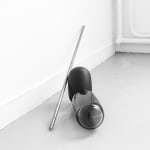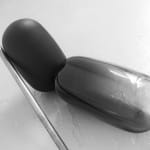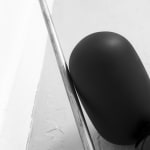




Célestine Peuchot
Further images
"News from nowhere" seems to find its points of balance through invisible forces. The work of glass has been challenged here to be able to enclose powerful magnets leaving the possibility for these fragile elements to compose themselves and take place in the space as they can, like a moment in suspension. Each glass capsule, enclosing a magnet, and the metal profile itself magnetized, take place in-situ by clinging to the architectural metal points of the exhibition space. "A crossroads where influences and reactions mingle". These were the terms chosen by the philosopher of science François Dagognet who, in Faces, Surfaces, Interfaces, undertook to rehabilitate the membrane of things against the fetishisation of hidden meaning. Célestine Peuchot's series "Anatomie de Surfaces", of which this piece is a part, seems to be both a spatialization and a deepening of this quest for a societal transition that is as ecological as it is aesthetic. The destabilization of perceptive reflexes culminates in this blown glass sculpture held in equilibrium by the magnetic field of magnets which, through a tiny action, awakens the slow anaesthesia of habit and the necessary measurement of human actions. In these glass pieces, the fragility of the points of contact, often close to breaking, refers to the unbearable representation we have of the world.
This research into the idea of transparency and movement places matter at the heart of the universe, within which we humans work to achieve a fragile and fleeting balance. Haptic and sensory, these pieces made from broken glass, melted by fire and blown by humans, engage in an intimate and direct conversation with the viewer to renew our relationship to matter and the cycle of its transformations.
Exhibitions
2018
Palais des Beaux Arts, Paris
2017
Galerie Ourcq Blanc




